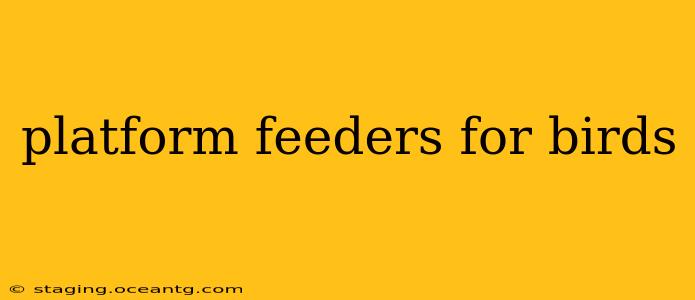Choosing the right bird feeder can significantly impact the variety and number of feathered friends visiting your backyard. Platform feeders, in particular, offer a unique approach to bird feeding, attracting a diverse range of species. This comprehensive guide explores the benefits, drawbacks, and best practices for using platform feeders to enhance your birdwatching experience.
What are Platform Bird Feeders?
Platform feeders, as the name suggests, are simple, flat surfaces designed to hold birdseed. Unlike tube or hopper feeders, they offer open access to food, making them ideal for birds that prefer to feed on the ground or on a wide, open surface. Their design encourages different feeding styles and accommodates a variety of bird sizes and species.
What are the Advantages of Using Platform Feeders?
- Attracts a Wide Variety of Birds: The open design allows various bird species, including those that can't easily cling to hanging feeders, to access the food. This includes ground-feeding birds like juncos, sparrows, and doves.
- Easy to Fill and Clean: Platform feeders are generally easy to access and clean, making maintenance straightforward. Regular cleaning is crucial to prevent the spread of disease among birds.
- Suitable for Different Types of Birdseed: You can use a wide array of seeds and grains in a platform feeder, catering to the diverse dietary preferences of different birds.
- Affordable and Accessible: Platform feeders are often more affordable than other feeder types, making them a budget-friendly option for attracting birds to your yard.
- Visual Appeal: Many platform feeders are aesthetically pleasing and can complement your garden's design.
What are the Disadvantages of Using Platform Feeders?
- Larger Birds Might Dominate: Larger birds may bully smaller birds away from the feeder, reducing the diversity of species that can feed successfully.
- More Susceptible to Weather: The open design means the food is more exposed to the elements, potentially leading to spoilage or waste due to rain or snow.
- Increased Risk of Seed Waste: Seeds can be scattered and wasted more easily with platform feeders compared to enclosed feeders.
- More Prone to Pest Infestation: The open design makes the food more accessible to squirrels, rodents, and other unwanted pests.
What Types of Birds are Attracted to Platform Feeders?
Many bird species are drawn to platform feeders. Some of the most common include:
- Juncos: These small, ground-feeding birds are frequent visitors to platform feeders.
- Sparrows: Various sparrow species appreciate the open access to seeds provided by platform feeders.
- Doves: Doves are ground feeders and readily utilize platform feeders.
- Mourning Doves: A common sight at platform feeders, particularly if you provide cracked corn or millet.
- Ground Feeding Cardinals: Cardinals will also utilize platform feeders.
How to Choose the Right Platform Feeder?
Selecting the right platform feeder involves considering several factors:
- Size: Choose a size appropriate for your yard and the number of birds you expect to attract.
- Material: Durable materials like metal or sturdy plastic are preferable to withstand the elements and wear and tear.
- Design: Look for designs with features like raised edges to minimize seed spillage and perches to accommodate various bird species.
- Ease of Cleaning: Opt for feeders with easily removable parts for convenient cleaning.
How Often Should I Clean My Platform Feeder?
Regular cleaning is vital to prevent the spread of diseases. Aim to clean your platform feeder at least once a week, or more frequently in warm, humid conditions. Remove all old seed, wash thoroughly with soap and water, and allow it to dry completely before refilling.
How Can I Prevent Squirrels and Other Pests from Accessing the Feeder?
Squirrels and other pests can be a nuisance at platform feeders. Consider these strategies:
- Squirrel-resistant design: Look for feeders with features that deter squirrels, such as baffles or strategically placed perches.
- Placement: Place the feeder in a location that is difficult for squirrels to access, such as hanging it from a tree branch or mounting it on a pole.
- Use of deterrents: While not always effective, some bird enthusiasts use commercial squirrel repellents.
By carefully considering these factors, you can select and maintain a platform feeder that effectively attracts a diverse range of birds to your backyard, providing hours of enjoyable birdwatching. Remember, responsible bird feeding involves providing clean food and a safe environment for your feathered friends.
